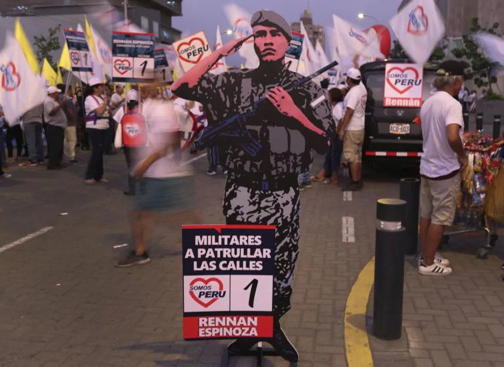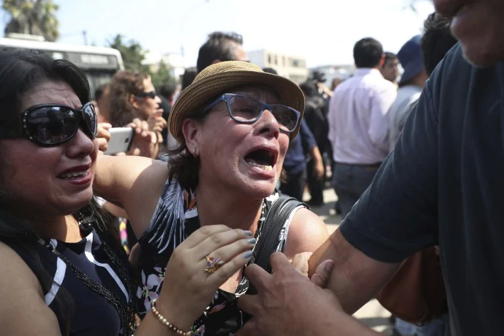
(above) A cardboard cutout of a soldier outside a debate Sunday in Lima, Peru, promotes a congressional candidate running on a security platform. (Martin Mejia/AP)
Voters in Peru have a rare opportunity to replace a corrupt Congress with reformers. Will they?
January 24, 2020 - Original article: Washington Post
by Simeon Tegel
LIMA, Peru — Months after President Martín Vizcarra dissolved Peru's scandal-racked Congress, voters head to the polls Sunday for a rare opportunity to clean up public life here and make politics more responsive.
But Peruvians appear increasingly unlikely to take it.
Four out of five approved of Vizcarra’s drastic measure in September, seen by some as helping Peru avoid the mass protests that have roiled its South American neighbors.
But in the days before the special election to seat a new Congress, polls show widespread public apathy — suggesting the possibility of a splintered body with no working majority and little legitimacy.
None of the 21 competing parties consistently register support in the double digits. In a country where voting is compulsory, the most popular option by far is spoiling the ballot — defacing it, or leaving it blank — the preference of roughly 40 percent of voters.
“People wanted change, but they’re not necessarily informing themselves about the new candidates,” said Alfredo Torres, president of pollster Ipsos Peru. “Predictably, they may end up voting for more of the same, which then would lead to even more disenchantment.”
(below) Workers remove campaign signs from an area where they are not allowed to be displayed, in Lima on Jan. 17. (Martin Mejia/AP)

Centrist parties appear likely to predominate, but the outcome is difficult to predict. Peruvians tend to decide their vote at the last minute, and the country’s electoral list system redistributes ballots from parties that receive less than 5 percent of the vote to larger parties. (That controversial system could itself be overhauled by a new legislature.)
“Anything is possible,” warned political scientist Fernando Tuesta, who headed a commission appointed by Vizcarra to recommend political reforms.
Vizcarra’s agenda includes measures to curb the parliamentary immunity that has repeatedly shielded members accused of flagrant crimes; stricter campaign finance rules to get dirty money out of politics; and a shake-up of the creaking court system.
Peru’s president dissolved Congress. Then Congress suspended the president. Who’s in charge now?
The last Congress sparked fury for delaying that agenda, shielding former president Alan García from corruption allegations and its own never-ending scandals. Prosecutors accused individual lawmakers of a range of offenses: taking bribes, selling army diesel on the black market, groping a flight attendant.
Most of the new candidates are relative unknowns. The new Congress will serve for just over a year, until the current legislative term runs out. Neither the lawmakers who were thrown out in September nor those who win on Sunday may run for reelection in 2021.
Arguably the two best-known candidates are Rosa Bartra and Yeni Vilcatoma, outspoken former members of the Fujimorista Popular Force party that dominated the last Congress and who are now running for another hard-right party, National Solidarity. Bartra has made headlines by accusing state schools of teaching children to masturbate with “blades and screws.” National Solidarity is polling at less than 1 percent.
(below) Peruvian President Martín Vizcarra attends a swearing-in ceremony at the government palace in Lima in October. (Guadalupe Pardo/Reuters)

Peru continues to reel from the wide-ranging Odebrecht scandal, which has ensnared the four previous presidents, and an unrelated graft case involving a network of allegedly crooked magistrates led by a Supreme Court judge, César Hinostroza, now fighting extradition from Spain.
Investigators of the Odebrecht scandal, in which the Brazilian construction giant paid nearly $800 million in bribes to secure public contracts across Latin America, say they plan to formally charge former presidents Alejandro Toledo and Ollanta Humala. Former president Pedro Pablo Kuczynski is under house arrest pending possible charges. García fatally shot himself in April as he was being arrested.
Former Peruvian president dead; shot himself as police attempted to make arrest
Also to be charged is Keiko Fujimori, the daughter of former president Alberto Fujimori and leader of the hard-right Popular Force party that dominated the dissolved Congress. Popular Force is expected to return, but in much smaller numbers, to the new Congress.
Toledo, Humala, Kuczynski and the younger Fujimori all deny taking secret payments from Odebrecht.
Former second vice president Omar Chehade of the Alliance for Progress party arrives with supporters at the debate Sunday in Lima. (Martin Mejia/AP)

But resistance to change within the judiciary threatens the continued success of those investigations.
Former attorney general Gonzalo Chávarry, formally accused of trying to shut down the Odebrecht probe, remains one of Peru’s five “supreme” prosecutors. And this week, the head of the Supreme Court, José Luis Lecaros, was placed under criminal investigation for allegedly failing to disclose that he had been approached for favors.
Ex-president’s suicide brings more criticism of Peru’s pretrial detentions
Peru’s electoral tribunal has also come under scrutiny. Ten days before Sunday’s vote, the tribunal ruled that new regulations to annul the registration of parties that win less than 5 percent of the popular vote will not apply for this election cycle.
That decision has been widely interpreted as intentionally favoring the APRA party of the late García, who wielded broad influence over the courts.
The tribunal also investigated Vizcarra for supposedly violating election neutrality laws by calling on voters to choose candidates committed to the anti-corruption crusade and who would vote to get rid of parliamentary immunity.
(below) Supporters of former Peruvian president Alan García react upon learning of his death, in Lima in April. (Martin Mejia/AP)

Sunday’s vote falls at a turbulent time in South America. Several of Peru’s neighbors have been rocked by mass protests in recent months.
Although the specific triggers in each case were distinct — electoral fraud in Bolivia, inequality in Chile, austerity in Ecuador — the common thread was public fury at governments viewed as failing to represent voters’ interests, a problem with equally deep roots in Peru.
“If we haven’t had that kind of uprising in Peru,” Tuesta said, “it’s perhaps because we have had other opportunities to express our rejection, including the prosecutions of [ex] presidents, the dissolution [of Congress] and now this election. These other countries did not have these escape valves.”
How to make sense of the many protests raging across South America
Vizcarra, 56, a businessman and former governor from the small southern Moquegua region, stepped up from the vice presidency in 2018 after Kuczynski resigned.
He is viewed as lacking charisma. But if he can build a legislative majority in the new Congress, he could yet be remembered as Peru’s most consequential president in decades.
“These institutional reforms could give him a real legacy,” said Arturo Maldonado, a political scientist at the Pontifical Catholic University of Peru.
“But it will all depend on the new Congress. It’s just as possible that we end up with gridlock again.”